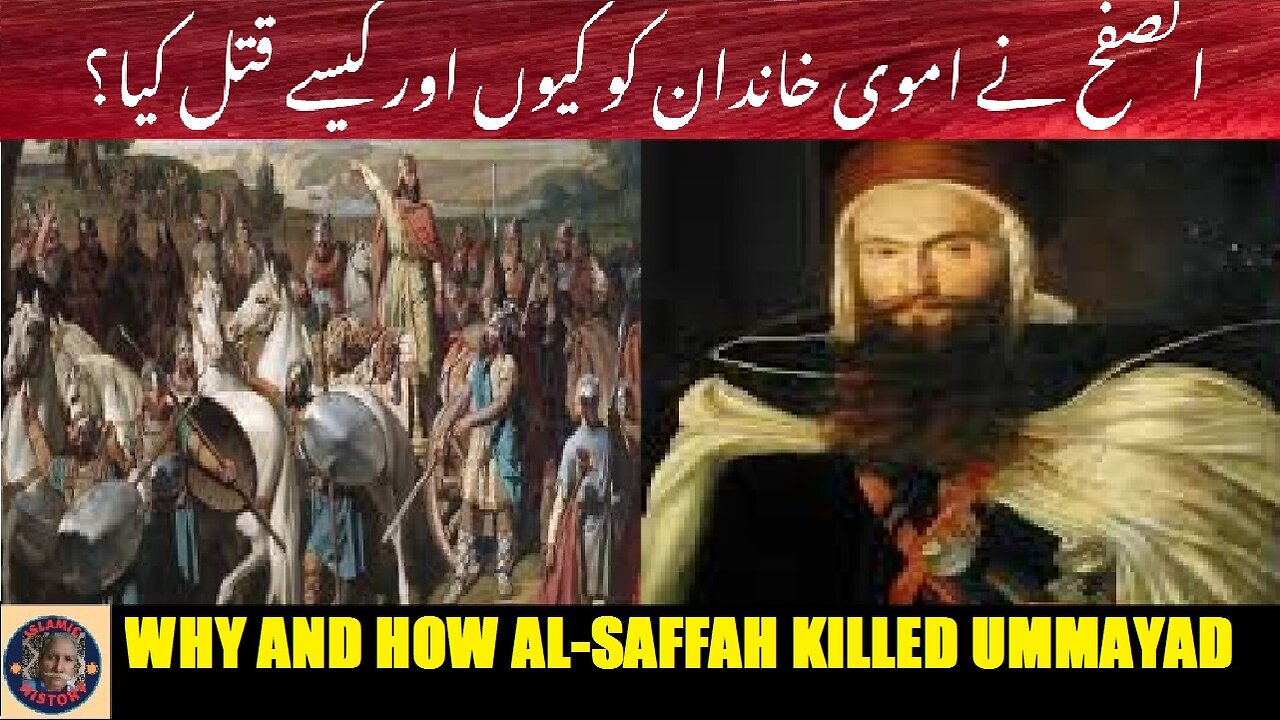Premium Only Content

Why and how Al-Saffah killed Umayyad family | الصفح نے اموی خاندان کو کیوں اور کیسے قتل کیا
@islamichistory813 #HistoricalAnalysis #PowerStruggles #MiddleEasternHistory
Why and how Al-Saffah killed Umayyad family?
Dekhti Aankhooon aur sountay kaanoon ko Asslamoalaikum, sisters, brothers friends and elders, In this informative video, we are describing the brutal rise of Al-Saffah and the systematic extermination of the Umayyad family, that Why and how Al-Saffah killed Umayyad family? By analyzing the historical backdrop and the key players involved, we aim to provide a comprehensive understanding of why Al-Saffah resorted to such drastic measures.
Later tales recount that, concerned that there would be a return of rival Umayyad power, as-Saffah invited all of the remaining members of the Umayyad family to a dinner party where he had them clubbed to death before the first course, which was then served to the hosts. The only survivor, Abd al-Rahman ibn Mu'awiya, escaped to the province of al-Andalus (Spain), where the Umayyad dynasty would endure for three more centuries in the form of the Emirate of Córdoba and the subsequent Caliphate of Córdoba. Another version is that as-Saffah's new governor to Syria, 'Abd Allah ibn 'Ali, hunted down the last of the family dynasty, with only Abd al-Rahm?n escaping. Ultimately, 'Abbasid rule was accepted even in Syria, and the beginning of the new Islamic dynasty was considered "free from major internal dissensions."
As-Saffah's four-year reign was marked with efforts to consolidate and rebuild the caliphate. His supporters were represented in the new government, but apart from his policy toward the Umayyad family, as-Saffah is widely viewed by historians as having been a mild victor. Jews, Nestorian Christians, and Persians were well represented in his government and in succeeding Abbasid administrations. Education was also encouraged, and the first paper mills, staffed by skilled Chinese prisoners captured at the Battle of Talas, were set up in Samarkand.
Equally revolutionary was as-Saff?h's reform of the army, which came to include non-Muslims and non-Arabs in sharp contrast to the Umayyads who refused any soldiers of either type. As-Saffah selected the gifted Abu Muslim as his military commander, an officer who would serve until 755 in the Abbasid army.
Not all Muslims accept the legitimacy of his caliphate, however. According to later Shi'ites, as-Saffah turned back on his promises to the partisans of the Alids in claiming the title caliph for himself. The Shi'a had hoped that their imam would be named head of the caliphate, inaugurating the era of peace and prosperity the millennialists had believed would come. The betrayal alienated as-Saff?h's Shi'a supporters, although the continued amity of other groups made Abbasid rule markedly more solvent than that of the Umayyads.
Caliph Abu al-`Abbas `Abdu’llah as-Saffah died of smallpox on 8 June 754 (13 Dhu al-Hijja 136 AH), only four years after taking the title of caliph. Before he died, as-Saffah appointed his brother Abu Ja'far al-Mansur[1] and, following him, the caliph's nephew Isa ibn Musa as his successors; ibn Musa, however, never filled the position.
During his reign a great battle took place in 751 known as the Battle of Talas or Battle of Artlakh was a military engagement between the Abbasid Caliphate along with their ally the Tibetan Empire against the Chinese Tang dynasty. In July 751 AD, Tang and Abbasid forces met in the valley of the Talas River to vie for control over the Syr Darya region of central Asia. After several days of stalemate, the Karluk Turks originally allied to the Tang defected to the Abbasids and tipped the balance of power, resulting in a Tang rout.
The defeat marked the end of Tang westward expansion and resulted in Muslim control of Transoxiana for the next 400 years. Control of this region was economically beneficial for the Abbasids because it was on the Silk Road. Historians debate whether or not Chinese prisoners captured in the aftermath of the battle brought paper-making technology to the Middle East, where it eventually spread to Europe.
The numbers of combatants involved in the Battle of Talas are not known with certainty; however, various estimates exist. The Abbasid army (200,000 Muslim troops according to Chinese estimates, though these numbers may be greatly exaggerated) which included contingents from their Tibetan ally met the combined army of 10,000 Tang Chinese and 20,000 Karluk mercenaries (Arab records put the Chinese forces at 100,000 which also may be greatly exaggerated).
So sisters brothers friends and elders, tomorow we are going to described War between Abbasid and Chinese Force and death of Al-Saffah. Allah hafiz
=================================
-
 5:40
5:40
ISLAMIC HISTORY
3 hours agoScholar Dr. Tahira Qutubuddin doctor taaharah qatb aldin سکالر ڈاکٹر طاہرہ قطب الدین
4 -
 21:14
21:14
Jasmin Laine
47 minutes ago“Absolute Nonsense Policy”—CBC Guest DROPS Savage TRUTH! Poilievre LEAVES Reporters SPEECHLESS
5 -
 2:01:48
2:01:48
The Charlie Kirk Show
3 hours agoZero Percent Approval Democrats + Two Million Deportations | Bergquam, Sec. Noem, Bowyer | 8.29.2025
39.5K17 -
 1:52:52
1:52:52
Tucker Carlson
2 hours agoSSRIs and School Shootings, FDA Corruption, and Why Everyone on Anti-Depressants Is Totally Unhappy
15.6K37 -
 2:18:15
2:18:15
Side Scrollers Podcast
4 hours agoBlizzard BANS Player for Saying “n00b” + Cracker Barrel Ends PRIDE Funding + MORE | Side Scrollers
9.79K5 -
 LIVE
LIVE
Jeff Ahern
50 minutes agoFriday Freak out with Jeff Ahern
108 watching -
 LIVE
LIVE
Reidboyy
1 hour agoHow To Make $$$ in Delta Force Console Operations!
28 watching -
 1:59:29
1:59:29
Tim Pool
4 hours agoIsrael VS Palestine DEBATE, Misfit Patriot VS Rathbone | The Culture War with Tim Pool
108K165 -
 15:53
15:53
Talk Nerdy Sports - The Ultimate Sports Betting Podcast
1 hour agoIt’s Friday, August 30, 2025 and Talk Nerdy Sports is loading up 10 rock-solid bets
4 -
 34:17
34:17
Ohio State Football and Recruiting at Buckeye Huddle
11 hours agoOhio State Football: 14 Bold Predictions for the Buckeyes vs. Longhorns
4.21K